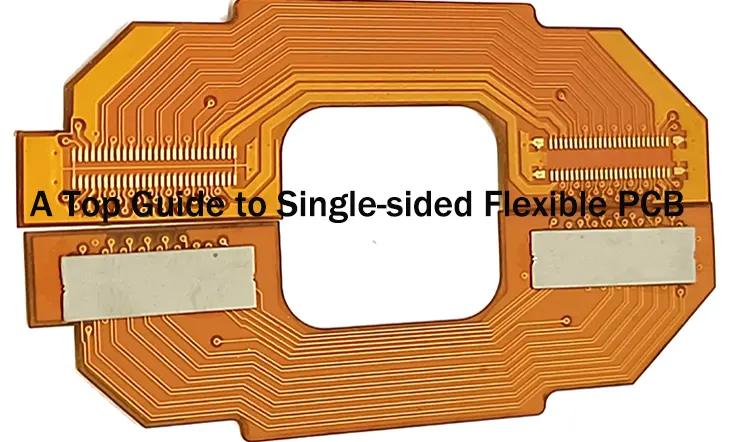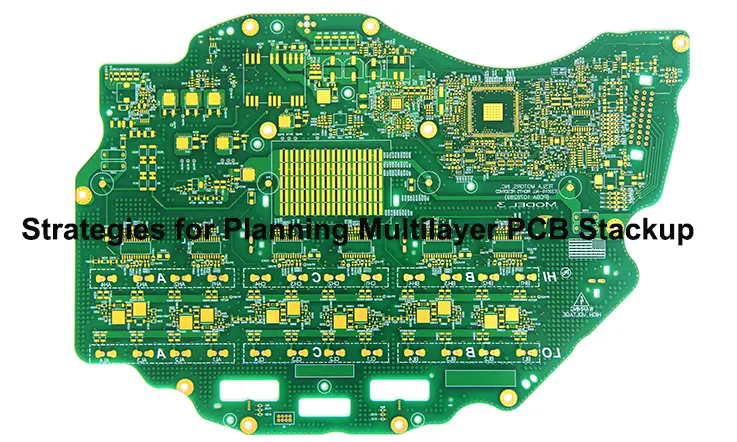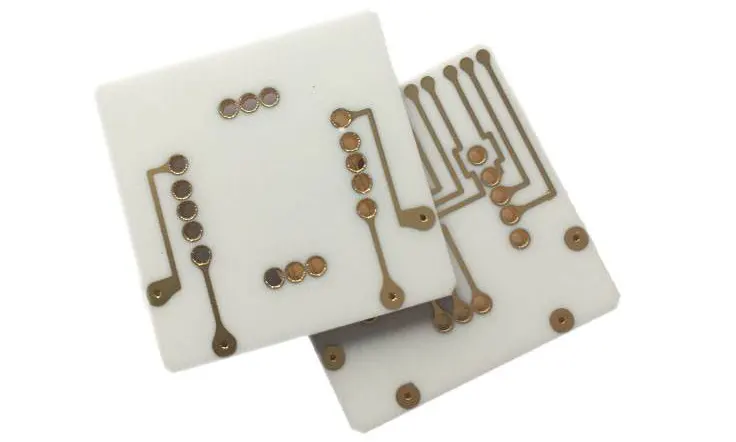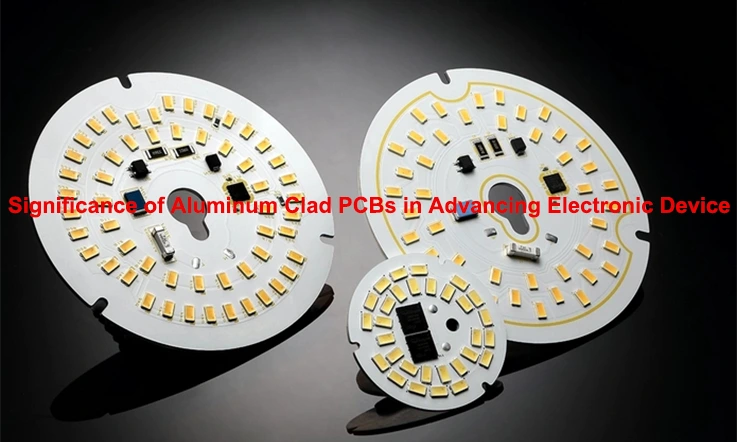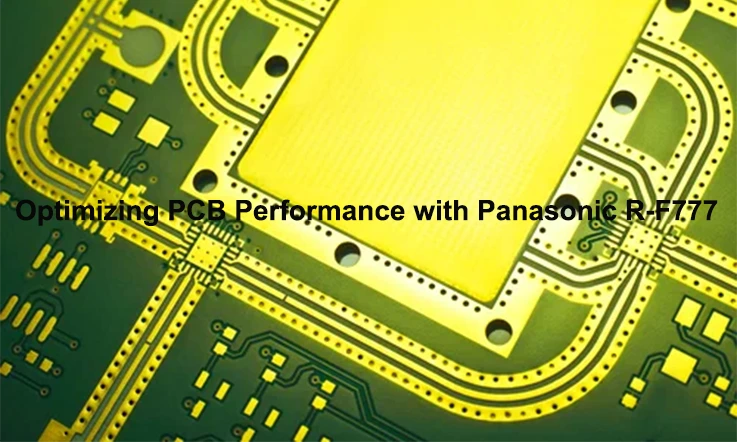
In the field of electronic engineering, the choice of PCB substrate materials plays a vital role in the performance and reliability of electronic devices. The Panasonic R-F777, a renowned PCB Boards materials, is known for its advanced PCB substrates that offer exceptional performance characteristics. These substrates are designed to meet the demanding requirements of electronic engineers and are a result of continuous research and development efforts by Panasonic.
The Panasonic R-F777 PCB substrates are carefully selected to provide excellent electrical performance, mechanical strength, thermal stability, and signal integrity. These materials are engineered to withstand high-frequency applications, ensuring low signal loss and minimal distortion. Electronic engineers rely on the Panasonic R-F777 substrates to achieve superior performance and reliability in their designs.
Features and Benefits of Panasonic R-F777 Materials
Panasonic R-F777 PCB materials play a crucial role in the performance and reliability of printed circuit boards. Here are some common features and benefits that Panasonic R-F777 offer:
Electrical Performance: Panasonic R-F777 should have excellent electrical properties, such as low dielectric constant (Dk) and low dissipation factor (Df), to minimize signal loss and ensure signal integrity.
Thermal Performance: Good thermal conductivity is important to dissipate heat generated by electronic components on the PCB. Materials with high thermal conductivity help maintain lower operating temperatures and improve the reliability of the circuitry.
Mechanical Strength: Panasonic R-F777 should have sufficient mechanical strength to withstand the stresses and strains during fabrication, assembly, and operation. High-quality materials offer good dimensional stability, rigidity, and resistance to bending or warping.
Chemical Resistance: Panasonic R-F777 should be resistant to chemicals, moisture, and environmental factors to ensure long-term reliability and performance. They should be able to withstand exposure to solvents, cleaning agents, and various operating conditions.
RoHS Compliance: RoHS (Restriction of Hazardous Substances) compliance is essential forPanasonic R-F777 to meet environmental regulations and ensure the safety of the end product. RoHS-compliant materials are free from hazardous substances like lead, mercury, cadmium, and certain flame retardants.
Processability: Panasonic R-F777 should be easy to process during fabrication, such as drilling, plating, and soldering. Materials with good dimensional stability and compatibility with standard PCB manufacturing processes help improve production efficiency.
It’s important to note that the specific features and benefits of the Panasonic R-F777 PCB materials may vary, and it’s best to refer to the official documentation or contact Panasonic directly for detailed information about their product line.
Disadvantages of Using Panasonic R-F777
Cost: Some high-performance PCB materials, including specialized materials like Panasonic R-F777, may be more expensive compared to standard materials.
Availability: Specialized PCB materials may have limited availability, which can make it challenging to source them in large quantities or in certain regions.
Processing: Some PCB materials may require special handling or processing techniques that can add complexity to the manufacturing process.
Compatibility: Certain PCB materials may have specific compatibility requirements with respect to soldering processes, surface finishes, or other assembly techniques.
Environmental Impact: It’s important to consider the environmental impact of the chosen PCB material, including factors such as recyclability and compliance with regulations.
Applications and Industries for R-F777 PCB Materials
Panasonic R-F777 PCB materials are used in a variety of applications and industries due to their specific characteristics and performance. Here are some potential applications and industries where R-F777 materials may be suitable:
Telecommunications:
R-F777 materials can be used in the manufacturing of high-frequency communication devices such as antennas, transceivers, base stations, and satellite communication systems.
Aerospace and Defense:
These materials may find applications in aerospace and defense industries for the production of radar systems, avionics, military communication equipment, and satellite systems where high performance, reliability, and signal integrity are crucial.
Automotive Electronics:
R-F777 materials can be utilized in automotive electronics for applications such as advanced driver-assistance systems (ADAS), radar systems, infotainment systems, and engine control units (ECUs).
Industrial Control Systems:
The materials may be suitable for industrial control systems, including programmable logic controllers (PLCs), motor drives, power supplies, and automation equipment.
Medical Devices:
R-F777 materials might be utilized in medical equipment such as diagnostic devices, imaging systems, patient monitoring systems, and medical implants that require high-frequency signal transmission and reliability.
Consumer Electronics:
These materials could be used in consumer electronics, including smartphones, tablets, wearables, and wireless communication devices, where high-speed data transmission and signal integrity are important.
Comparison with Other PCB Material Options
When comparing Panasonic R-F777 PCB materials with other options, it’s important to consider various factors such as electrical performance, thermal characteristics, mechanical strength, cost, and availability. While I don’t have specific information about R-F777, I can provide a general comparison between different types of PCB materials:
Flexible Materials:
Flexible PCB materials, like polyimide (PI) or polyester (PET), provide flexibility and can be bent or twisted to fit specific form factors. They are commonly used in applications where space constraints or dynamic movements are present, such as wearable devices, flexible displays, and automotive electronics.
FR-4:
FR-4 is a widely used and cost-effective PCB material. It offers good electrical insulation, mechanical strength, and is suitable for most standard applications. However, it may have limitations in high-frequency and high-speed applications due to its relatively higher dielectric constant and loss tangent.
High-Frequency Materials:
For applications requiring high-frequency performance, materials like Rogers RO4000 series or Taconic TLY series are commonly used. These materials have low dielectric loss, low signal loss, and excellent high-frequency performance. They are suitable for applications such as RF circuits, microwave devices, and high-speed digital designs.
Ceramic-based Materials:
Ceramic PCB materials, such as aluminum oxide (Al2O3) or aluminum nitride (AlN), offer excellent thermal conductivity and high-temperature resistance. They are often used in power electronics, LED applications, and high-power RF amplifiers where heat dissipation is critical.
Metal Core Materials:
Metal core PCB materials, like aluminum or copper, have a metal layer sandwiched between the dielectric layers. They offer excellent heat dissipation and are commonly used in high-power LED lighting, automotive lighting, and power electronics applications.
It’s essential to evaluate the specific requirements of your application and consult with PCB material manufacturers or suppliers to determine the best material option. They can provide detailed technical information, performance data, and guidance based on your specific needs.
Key Factors in Utilizing Panasonic R-F777 for PCBs Design and Manufacturing
When choosing Panasonic R-F777 for PCB design and manufacturing, it’s important to consider the following aspects of the design and manufacturing process:
1. Design Considerations:
Material Properties: Understand the specific properties of Panasonic R-F777, such as dielectric constant, dissipation factor, thermal conductivity, and mechanical strength. These properties will impact the performance and reliability of the PCB.
Signal Integrity: Consider the high-frequency performance requirements of your design and ensure that Panasonic R-F777 meets the necessary signal integrity specifications.
Thermal Management: Evaluate the thermal conductivity and heat dissipation capabilities of Panasonic R-F777 to ensure efficient thermal management in your design.
Manufacturing Compatibility: Verify that your design is compatible with the manufacturing processes and capabilities associated with Panasonic R-F777.
2. Manufacturing Process:
Material Selection: Specify Panasonic R-F777 as the chosen material during the PCB manufacturing process.
PCB Fabrication: Work with a PCB manufacturer experienced in handling Panasonic R-F777 to ensure proper fabrication techniques are employed. This may include specific considerations for drilling, plating, and etching processes.
Component Placement: Optimize component placement to minimize signal loss and ensure proper thermal management, considering the characteristics of Panasonic R-F777.
PCB Assembly: Follow industry-standard assembly processes, such as surface mount technology (SMT) or through-hole technology (THT), depending on the specific requirements of your design.
Quality Control: Implement stringent quality control measures during the manufacturing process to ensure the reliability and performance of the final PCB.
3. Testing and Validation:
Electrical Testing: Perform electrical testing, such as continuity checks, impedance testing, and signal integrity analysis, to verify the performance of the PCB.
Thermal Testing: Conduct thermal testing to assess the thermal management capabilities of the PCB, ensuring that it can handle the expected heat dissipation requirements.
Reliability Testing: Subject the PCB to reliability tests, such as thermal cycling, vibration testing, and accelerated aging, to validate its long-term performance and durability.
It’s important to note that the design and manufacturing process may vary depending on the specific requirements of your project and the capabilities of your chosen PCB manufacturer. Consulting with experienced PCB designers and manufacturers, as well as referring to the documentation and guidelines provided by Panasonic, can help ensure a successful design and manufacturing process when using Panasonic R-F777.
How to Store Panasonic R-F777?
To ensure the optimal performance and longevity of Panasonic R-F777 PCB substrates, proper storage practices should be followed. Here are some guidelines for storing Panasonic R-F777 materials:
1. Temperature and Humidity: Store the R-F777 substrates in a controlled environment with stable temperature and humidity levels. Ideally, the temperature should be between 10°C and 30°C (50°F and 86°F), and the relative humidity should be maintained below 60%. Avoid storing the substrates in areas prone to extreme temperature fluctuations or high humidity, as it can lead to material degradation.
2. Moisture Protection: Protect the R-F777 substrates from moisture and water exposure. Moisture can adversely affect the electrical properties and performance of the materials. Store the substrates in airtight packaging or containers, preferably with moisture-absorbing desiccants to minimize moisture absorption. This is particularly important if the substrates are not sealed in their original packaging.
3. Handling and Stack Height: When storing R-F777 substrates, handle them with care to prevent physical damage. Avoid dropping or mishandling the materials, as it can result in cracks or delamination. Additionally, avoid stacking substrates too high to prevent excessive pressure on the lower layers, which can cause deformation or warping.
4. Clean and Dust-Free Environment: Store the R-F777 substrates in a clean and dust-free environment. Dust particles can accumulate on the surfaces and affect the electrical properties of the materials. If necessary, use protective covers or packaging to shield the substrates from dust and contaminants.
5. Shelf Life: While R-F777 substrates are designed for long-term use, it is recommended to use them within their specified shelf life. Check the manufacturer’s guidelines or datasheets for information on the recommended shelf life of the specific R-F777 material.
By following these storage guidelines, you can maintain the quality and performance of Panasonic R-F777 PCB substrates, ensuring that they are in optimal condition when used in electronic designs.
Conclusion
The Panasonic R-F777 PCB substrates are a testament to Panasonic’s commitment to delivering high-quality materials for electronic engineers. With their excellent electrical performance, mechanical strength, thermal stability, and signal integrity, these substrates enable engineers to design and develop cutting-edge electronic devices with confidence.
By leveraging the advanced features of the Panasonic R-F777 substrates, engineers can push the boundaries of technology, create innovative solutions, and meet the ever-increasing demands of modern electronic applications. With Panasonic’s dedication to research and development, we can anticipate further advancements in PCB substrate materials, opening up new possibilities for electronic engineers in the future.
As electronic engineering continues to evolve, Panasonic remains at the forefront, providing reliable and high-performance PCB substrate materials like the R-F777 to empower engineers and drive technological progress in the industry.

